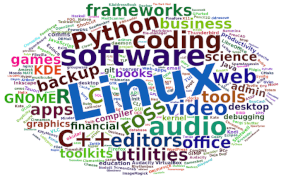Frontend developers appreciate the importance of UI design as it’s a critical part of developing an app. With terminal-based tools, visual design might not be foremost in a developer’s mind. While the design is constrained, it’s still important to communicate terminal output in the best way possible.
Adding color and styling to terminal output helps make a command line interface more engaging, informative, and easy to understand.
This roundup showcases the best tools for terminal string styling.
Here’s our verdict captured in a legendary LinuxLinks-style ratings chart. Only free and open source software is eligible for inclusion.

Let’s explore the 12 tools at hand. For each title we have compiled its own portal page, a full description with an in-depth analysis of its features, together with links to relevant resources.
| Terminal String Styling Tools | |
|---|---|
| Rich | Python library for rich text and beautiful formatting |
| Chalk | Bills itself as “Terminal string styling done right” |
| picocolors | Tiny and fast library for terminal output formatting |
| yoctocolors | Small and fast command-line coloring package |
| colorette | Set your terminal text color and styles |
| yachalk | Clone of Chalk written in Python |
| kleur | Node.js library for formatting terminal text with ANSI colors |
| sty | String styling for your terminal |
| ansi-colors | Add ANSI colors to terminal text |
| termcolor | ANSI color formatting for output in the terminal |
| colored | Simple Python library for color and formatting in terminal |
| ansicolors | ANSI colors for Python |
 Read our complete collection of recommended free and open source software. Our curated compilation covers all categories of software. Read our complete collection of recommended free and open source software. Our curated compilation covers all categories of software. Spotted a useful open source Linux program not covered on our site? Please let us know by completing this form. The software collection forms part of our series of informative articles for Linux enthusiasts. There are hundreds of in-depth reviews, open source alternatives to proprietary software from large corporations like Google, Microsoft, Apple, Adobe, IBM, Cisco, Oracle, and Autodesk. There are also fun things to try, hardware, free programming books and tutorials, and much more. |
